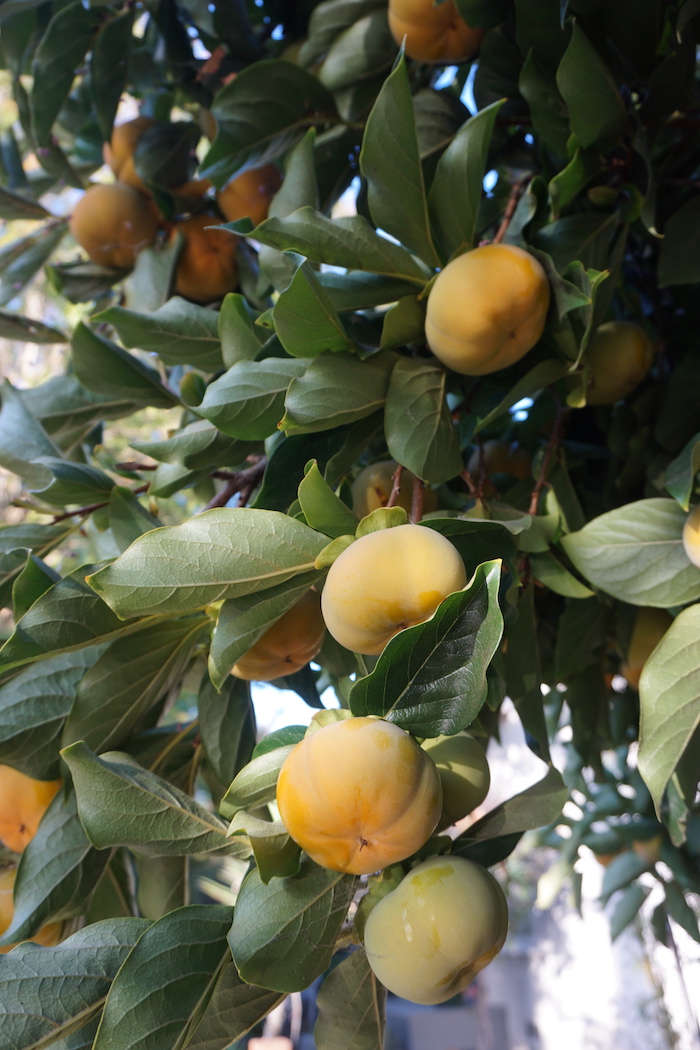Growth Patterns of the Persimmon Tree

The Hachiya tree is tall and vigorous, often 15–20 feet tall and as wide. The fruit too is large, 3–4 inches wide, and heart or acorn shaped. It has a warm, deep orange color and an almost subtle glow. Hachiyas are extremely astringent, laced with tannins, until fully ripe. Then they are like a sugar-water balloon—translucent skin encases innards that are a sweet mushy jelly with lots of sugar. A treat to eat! But, the fruit must be fully ripened and soft to eliminate the tannins and bring up the sugar content. You must wait. Be patient.
When I first came out to California from Boston some 50 years ago, I grabbed a few seemingly ripe Hachiyas from an unsuspecting roadside tree. When I bit into one, what I tasted was the equivalent of one part quinine, one part sandpaper, and one part cement mix, with a dose of paint thinner thrown in for good measure. Not exactly a divine fruit. Little did I know what pleasure the fruit acquired after ripening.
Hachiyas can be left on the tree to soften, sweeten, and ripen. Or they can be picked at full color but not mature and laid out in a single layer in a box and ripened in a cool room. They also can be refrigerated and kept for up to 3 months, then brought out and ripened incrementally. When ripe, they can be eaten out of hand, although they are a bit messy. It’s easier to cut them in half and spoon the sweet flesh, or just cut the top off the fruit and spoon it. In a sense, Hachiyas are a bit like zucchinis: once they are ripe, you’ve got way too many. As with zukes, you can make bread or cookies and give them away. They also make a good pudding.
Fuyu, the second type of Japanese persimmon, is also called apple persimmon. Both the fruit and the tree are smaller than the Hachiya. The fruit is four lobed, oblate, and squat, not unlike the shape of a tomato or perhaps an apple, though its taste and texture in no way resemble an apple, thankfully. It is applelike in that it is nonastringent, a bit crisp and crunchy, and can be eaten out of hand. But the flavor is something else . . . Fuyus needn’t be soft to be ripe and sweet, just richly colored. The Fuyu tree is a bit more timid and well behaved than the Hachiya. It usually tops out at a modest 8–12 feet tall. It fits nicely into the small home landscape.

Persimmons leaf in the spring and set green fruit in the summertime. As summer turns into autumn, the innocuous, dull green fruits start to color, eventually achieving a warm orange-red at maturity. The fruit has an almost subtle glow. In a similar vein, the green leaves ignite with fiery tones of red, yellow, and orange. Then suddenly, often aided by a windblown autumn day, the leaves are on the ground, and the tree’s silhouette stands dormant with light, fawn-colored branches and orange fruit. It is unusual to see a tree dormant, leafless, and still bearing fruit, but so it is with the persimmon. The tree has an almost mythological look at this point.
Once the tree drops all its leaves, you had better get busy and harvest the fruit. Yes, it could be left to ripen on the tree, but the scavenging trifecta of crows, raccoons, and squirrels bid you to harvest. Use hand pruners when harvesting, and take a short stem with the fruit, about 1⁄2 inch long. With fruits and vegetables, a stem is simply a buffer between the item and desiccation or rot. Stems on fruits are important and extend the postharvest shelf life (a protective cloak). If you’re growing Hachiyas, a good way to make sure squirrels don’t get more of your harvest than you do is to preserve your persimmons. You can do this with a food dehydrator, or look into the much more laborious (and incredibly cool) traditional Japanese method of making delicious Hoshigaki.
Reprinted from Fruit Trees for Every Garden.
Copyright © 2019 by Orin Martin and Manjula Martin.
Photographs copyright © 2019 by Liz Birnbaum.
Etchings and illustrations copyright © 2019 by Stephanie Zeiler Martin.
Published by Ten Speed Press, an imprint of Penguin Random House LLC.
